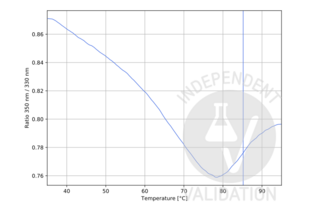Cathepsin G antibody (Internal Region)
-
- Target See all Cathepsin G (CTSG) Antibodies
- Cathepsin G (CTSG)
-
Binding Specificity
- Internal Region
-
Reactivity
- Human
-
Host
- Rabbit
-
Clonality
- Polyclonal
-
Conjugate
- This Cathepsin G antibody is un-conjugated
-
Application
- Western Blotting (WB), ELISA
- Specificity
- Cathepsin G Polyclonal Antibody detects endogenous levels of Cathepsin G protein.
- Characteristics
- Rabbit Polyclonal to Cathepsin G.
- Purification
- The antibody was affinity-purified from rabbit antiserum by affinity-chromatography using epitope-specific immunogen.
- Immunogen
- Synthesized peptide derived from the Internal region of human Cathepsin G.
- Isotype
- IgG
- Top Product
- Discover our top product CTSG Primary Antibody
-
-
- Application Notes
- WB 1:500-1:2000, ELISA 1:40000,
- Restrictions
- For Research Use only
-
- by
- NanoTemper Technologies
- No.
- #102721
- Date
- 11/05/2018
- Antigen
- CTSG
- Lot Number
- 022204892
- Method validated
- Unfolding Profile
- Positive Control
- ABIN3183694
- Negative Control
- Notes
Passed. ABIN3183694 showed Ti at 85.2°C and a clear unfolding profile with one unfolding event. This suggests that the protein is properly folded and functional.
- Primary Antibody
- ABIN3183694
- Secondary Antibody
- Full Protocol
- Dilute ABIN3183694 1:10 in PBS buffer (Roth, 1058.1, lot 285231988) to get a final volume of 15µl at a concentration of 0.67µM.
- Load sample into Tycho capillary (NanoTemper Technologies, TY-C001).
- Run Tycho measurement.
- Experimental Notes
Tycho is designed to run quick and precise protein quality check experiments. Tycho uses intrinsic protein fluorescence to follow protein unfolding while running a fast thermal ramp, yielding results in 3min. A protein’s unfolding behavior is characterized by various parameters, most notably the inflection temperature (Ti). The Ti can be used to identify properly folded protein, to compare different batches, or to analyze the influence of storage/transport conditions on a protein. An absence of Ti would suggest that the protein is already unfolded and therefore most likely nonfunctional.
Validation #102721 (Unfolding Profile)![Successfully validated 'Independent Validation' Badge]()
![Successfully validated 'Independent Validation' Badge]() Validation Images
Validation Images![p>Unfolding profile of ABIN3183694. The fluorescence signal is plotted against temperature. The native (folded) protein has a high signal at the beginning of the experiment, which decreases and then again increases upon unfolding, showing one unfolding event. The vertical line indicates the Ti at 85.2°C.]() p>Unfolding profile of ABIN3183694. The fluorescence signal is plotted against temperature. The native (folded) protein has a high signal at the beginning of the experiment, which decreases and then again increases upon unfolding, showing one unfolding event. The vertical line indicates the Ti at 85.2°C.
Full Methods
p>Unfolding profile of ABIN3183694. The fluorescence signal is plotted against temperature. The native (folded) protein has a high signal at the beginning of the experiment, which decreases and then again increases upon unfolding, showing one unfolding event. The vertical line indicates the Ti at 85.2°C.
Full Methods -
- Format
- Liquid
- Concentration
- 1 mg/mL
- Buffer
- Liquid in PBS containing 50 % glycerol, 0.5 % BSA and 0.02 % sodium azide.
- Preservative
- Sodium azide
- Precaution of Use
- This product contains Sodium azide: a POISONOUS AND HAZARDOUS SUBSTANCE which should be handled by trained staff only.
- Handling Advice
- Avoid repeated freeze/thaw cycles.
- Storage
- -20 °C
- Storage Comment
- Store at -20°C.
-
- Target
- Cathepsin G (CTSG)
- Alternative Name
- Cathepsin G (CTSG Products)
- Molecular Weight
- 22 kDa
- Gene ID
- 1511
- UniProt
- P08311
- Pathways
- ACE Inhibitor Pathway, Peptide Hormone Metabolism, Regulation of Systemic Arterial Blood Pressure by Hormones
-


 (1 validation)
(1 validation)



